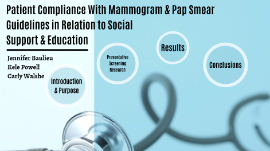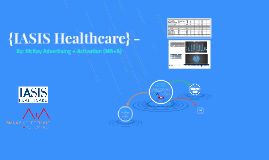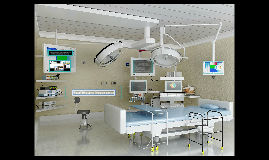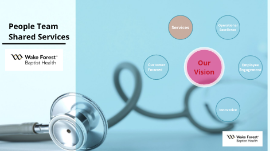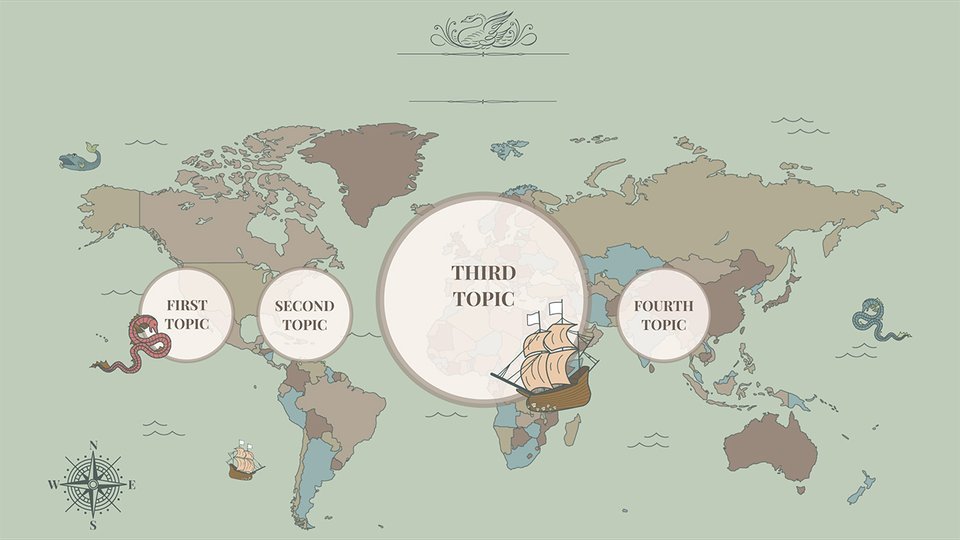Healthcare Presentation
Transcript: Patient Compliance With Mammogram & Pap Smear Guidelines in Relation to Social Support & Education Introduction & Purpose Jennifer Baulieu Kele Powell Carly Walshe To assess the compliance of patients in health screening tests including pap smear and mammogram in relation to social support and education. How to improve compliance in preventative screening for all women. Current Guidelines from the US Preventative Services Task Force (2016): Women 21-65 years of age should have a pap smear every 3 years Those over 65 years can be stopped with 3 negative tests within the past 10 years Mammograms performed every 2 years in women 50-74 Ages 40-49 are based on risk factors Introduction & Purpose At one time cervical cancer was a leading cause of death. In the last 40 years, mortality from cervical cancer has drastically declined due to pap smear screening. While breast cancer continues to remain a high mortality for women, mammograms can provide early detection and less invasive treatment. Misconceptions among high risk populations about preventative screening Correlation of education level and preventative screening compliance in women The influence of social support on women receiving preventative screening How healthcare providers and community members can improve patient compliance of recommended preventive screening practices Importance Topics Preventative Screening Research Preventative Screening Research Screening Screening Confusion About Pap Smears: Lack of Knowledge Among High-Risk Women Cervical Cancer screenings have increased since 2006, but high risk populations have misconceptions about Pap Smears. Myths about Pap Smears: They do not screen for all gynecologic cancers They do not screen for pregnancy They do not screen for STIs Confusion About Pap Smears: Lack of Knowledge Among High-Risk Women Confusion About Pap Smears: Lack of Knowledge Among High-Risk Women Cervical Cancer Disparities: African American women are 2x more likely than Caucasian women to die from cervical cancer ¹ Mortality rate is 50% higher among Hispanic women than non-Hispanic women ¹ College-age women are the most common age group with HPV Purpose: To examine knowledge among : Women with abnormal Pap-smears (pre-vaccine 2005-2006) College women (post vaccine 2008) Racial and ethnic minority college women (post vaccine 2011) Confusion About Pap Smears: Lack of Knowledge Among High-Risk Women Methodology: Assess the knowledge of women regarding the purpose of Pap-smears via surveys Study 1: Surveyed 154 women with abnormal Pap Smears Study 2: Surveyed 276 women who were undergraduate students Study 3: Surveyed 711 women who were undergraduate students that self-identified as part of a minority population Results: The percentage of women who were incorrect or unsure of whether Pap Smears tested for cervical cancer: Study 1: ~ 15% Study 2: ~ 25% Study 3: ~ 20% Each study found that women believed Pap smears tested for HPV, vaginal infections, yeast infections, gonorrhea, herpes, HIV/AIDS, and pregnancy Confusion About Pap Smears: Lack of Knowledge Among High-Risk Women Discussion: Statistically significant association between age and Pap smear knowledge Confusion can lead to delays and missed screenings and treatment opportunities for cervical cancer Women may not be receiving adequate information from their healthcare providers because even women in study 1 with an abnormal result had misconceptions Professional organizations need to develop clear and consistent health education messages Confusion About Pap Smears: Lack of Knowledge Among High-Risk Women Confusion About Pap Smears: Lack of Knowledge Among High-Risk Women Summary: Significant knowledge gaps remain among women Critical need for clear and consistent health education messages about the purpose, meaning, timing, and consequences of Pap smear testing beginning at an early age Messages need to address the need for screening, dispel myths, and be tailored for different populations Social Support and Education Social Support and Education The Association of Social Support and Education With Breast and Cervical Canc... In 2010, women... Mammogram in last 2 years: >50 years old: 72.4% >40 years old Less than a high school education: 58.3% High school degree: 69.5% College degree: 80.8% Pap Smear in last 3 years >21 years old: 83% Less than a high school education: 69.4% High school degree: 77.7% College degree: 89% The Association of Social Support and Education With Breast and Cervical Cancer Screening Purpose: Is there an association between social support and compliance with mammography and Pap test screening guidelines? Does social support moderate the effect of education on breast and cervical cancer screening? The Association of Social Support and Education with Breast and Cervical Cancer Screening Methodology: 2009-2010 Telephone survey 5,442 interviews with 66.1% cooperation rate Non-hispanic population due to small numbers Mammograms: >40 years old Compliance = past 2







